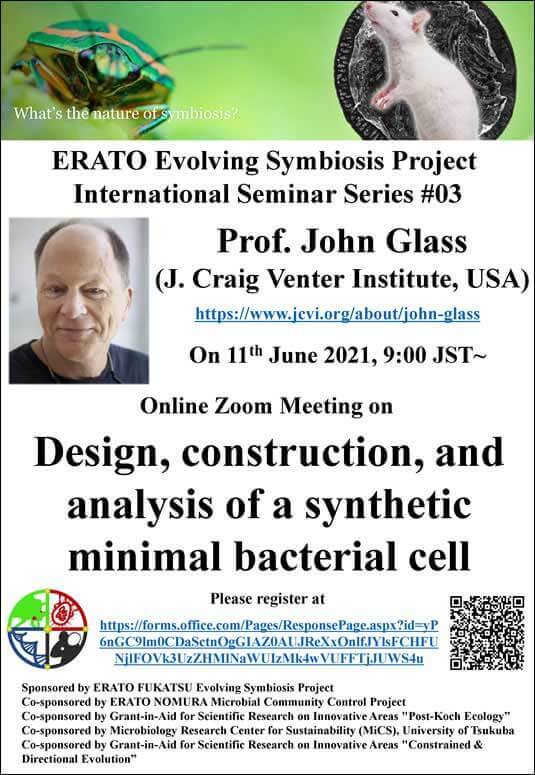第3回共生進化機構国際セミナー(6/11 9:00- by Prof. John Glass)のお知らせ
最小細胞や合成生物学の研究で世界をリードする米国クレイグ・ベンター研究所のProf. John Glassにご講演いただけることになりました。参加希望者は以下より登録ください。必要情報をお知らせいたします。
皆様の参加をお待ちしています。また、関心のありそうな方々への本アナウンスの周知を歓迎いたします。
https://www.jst.go.jp/erato/fukatsu/news/2021/210611.html
Date: 11 June 2021 09:00 (JST)-
Platform: Zoom Meeting
Lecturer: Prof. John Glass (J. Craig Venter Research Institute, USA)
Title: Design, construction, and analysis of a synthetic minimal bacterial cell
Abstract: The minimal cell is the hydrogen atom of cellular biology. Such a cell, because of its simplicity and absence of redundancy would be a platform for investigating just what biological components are required for life, and how those parts work together to make a living cell. Since the late 1990s, our team at the Venter Institute has been developing a suite of synthetic biology tools that enabled us to build what previously has only been imagined, a minimal cell. Specifically, a bacterial cell with a genome that expresses only the minimum set of genes needed for the cell to divide every two hours that can be grown in pure culture. That minimal cell has about half of the genes that are in the bacterium on which it was based, Mycoplasma mycoides JCVI syn1.0, the so-called synthetic bacteria we reported on in 2010. We used transposon bombardment to identify non-essential genes, and genes needed to maintain rapid growth in M. mycoides. Those findings required re-design and re-synthesis of some reduced genome segments. Three cycles of design, synthesis, and testing, with retention of quasi‐essential genes, produced synthetic bacterium JCVI‐ Syn3.0 (531 kb, 474 genes), which has a genome smaller than that of any autonomously replicating cell found in nature. Synthetic bacterium JCVI-Syn3.0 retains almost all genes involved in synthesis and processing of macromolecules. Surprisingly, it also contained 149 genes with unknown biological functions, suggesting the presence of undiscovered functions essential for life. This minimal cell is a versatile platform for investigating the core functions of life, and for exploring whole‐genome design. Since it was initially reported in 2016, we have identified functions for about 50 of the original 149 genes of unknown function. These findings have been used to create flux balance analysis and kinetic whole cell computational models of our minimal cell that replicate laboratory observations about our minimal cell. Additionally, we have used JCVI-syn3.0, which has an abnormal cell division and cell morphology phenotype, and a JCVI-syn3.0 mutant containing an additional seven non-essential genes that has divides normally and looks like wild type mycoplasma mycoides to investigate how modern cell division and cell size control might have evolved.
—————————————————-
This work was supported by Synthetic Genomics, Inc., DARPA Living Foundries contract HR0011-12-C-0063, and the J. Craig Venter Institute.
Website of Prof. Glass: https://www.jcvi.org/about/john-glass
第3回共生進化機構国際セミナー
Sponsored by ERATO FUKATSU Evolving Symbiosis Project
主催:ERATO深津共生進化機構プロジェクト
https://www.jst.go.jp/erato/fukatsu/
Co-sponsored by ERATO NOMURA Microbial Community Control Project
共催:ERATO野村集団微生物制御プロジェクト
https://www.jst.go.jp/erato/nomura/
Co-sponsored by Grant-in-Aid for Scientific Research on Innovative Areas
“Post-Koch Ecology”
共催:新学術領域研究「ポストコッホ生態」
https://postkoch.jp/about/
Co-sponsored by Microbiology Research Center for Sustainability (MiCS),
University of Tsukuba
共催:筑波大学微生物サステイナビリティ研究センター(MiCS)
https://www.mics.tsukuba.ac.jp/
Co-sponsored by Grant-in-Aid for Scientific Research on Innovative Areas
“Constrained & Directional Evolution”
共催:新学術領域研究「進化制約方向性」
http://constrained-evo.org/

